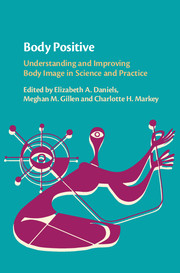Book contents
- Body Positive
- Body Positive
- Copyright page
- Dedication
- Contents
- Figures
- Tables
- Notes on Contributors
- Acknowledgments
- Introduction
- 1 Overview of the Field of Positive Body Image
- 2 Positive Body Image by Gender and Across the Lifespan
- 3 Considering Positive Body Image through the Lens of Culture and Minority Social Identities
- 4 Moving beyond Body Dissatisfaction and Risky Sexual Behavior
- 5 Appearance-Related Practices
- 6 Mindful Self-Care and Positive Body Image
- 7 The Health At Every Size® Paradigm
- 8 Better than Before
- 9 Programmatic Approaches to Cultivating Positive Body Image in Youth
- 10 Clinical Applications of Positive Body Image
- Index
- References
6 - Mindful Self-Care and Positive Body Image
Mindfulness, Yoga, and Actionable Tools for Positive Embodiment
Published online by Cambridge University Press: 29 June 2018
- Body Positive
- Body Positive
- Copyright page
- Dedication
- Contents
- Figures
- Tables
- Notes on Contributors
- Acknowledgments
- Introduction
- 1 Overview of the Field of Positive Body Image
- 2 Positive Body Image by Gender and Across the Lifespan
- 3 Considering Positive Body Image through the Lens of Culture and Minority Social Identities
- 4 Moving beyond Body Dissatisfaction and Risky Sexual Behavior
- 5 Appearance-Related Practices
- 6 Mindful Self-Care and Positive Body Image
- 7 The Health At Every Size® Paradigm
- 8 Better than Before
- 9 Programmatic Approaches to Cultivating Positive Body Image in Youth
- 10 Clinical Applications of Positive Body Image
- Index
- References
Summary
- Type
- Chapter
- Information
- Body PositiveUnderstanding and Improving Body Image in Science and Practice, pp. 135 - 159Publisher: Cambridge University PressPrint publication year: 2018
References
- 3
- Cited by

